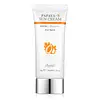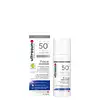What's inside
What's inside
 Key Ingredients
Key Ingredients

 Benefits
Benefits

 Concerns
Concerns

 Ingredients Side-by-side
Ingredients Side-by-side

Carica Papaya Fruit Water 43%
Skin ConditioningTitanium Dioxide
Cosmetic ColorantEthylhexyl Methoxycinnamate
UV AbsorberZinc Oxide
Cosmetic ColorantOctyldodecanol
EmollientDicaprylyl Carbonate
EmollientCoco-Caprylate/Caprate
EmollientC12-15 Alkyl Benzoate
AntimicrobialCetyl PEG/PPG-10/1 Dimethicone
EmulsifyingPentylene Glycol
Skin ConditioningNiacinamide
SmoothingHelianthus Annuus Seed Oil
EmollientDiethylamino Hydroxybenzoyl Hexyl Benzoate
UV FilterGlycerin
HumectantBis-Ethylhexyloxyphenol Methoxyphenyl Triazine
Skin ConditioningWater
Skin Conditioning1,2-Hexanediol
Skin ConditioningPolyglyceryl-3 Diisostearate
EmulsifyingMagnesium Sulfate
Beeswax
Emulsion StabilisingAluminum Hydroxide
EmollientDimethicone
EmollientPropanediol
SolventHydrogen Dimethicone
Disteardimonium Hectorite
StabilisingCarica Papaya Seed Oil
HumectantGlyceryl Caprylate
EmollientDimethicone/Vinyl Dimethicone Crosspolymer
Skin ConditioningTriethoxycaprylylsilane
Panthenol
Skin ConditioningButyrospermum Parkii Butter
Skin ConditioningBeta-Glucan
Skin ConditioningCarica Papaya Fruit Extract
Skin ConditioningXanthan Gum
EmulsifyingXylitylglucoside
HumectantAnhydroxylitol
HumectantXylitol
HumectantAdenosine
Skin ConditioningCarthamus Tinctorius Bud Extract
Skin ConditioningDisodium Adenosine Triphosphate
Skin ConditioningPapain
Skin ConditioningAlgin
MaskingGlucose
HumectantGeranium Maculatum Oil
MaskingCarica Papaya Fruit Water 43%, Titanium Dioxide, Ethylhexyl Methoxycinnamate, Zinc Oxide, Octyldodecanol, Dicaprylyl Carbonate, Coco-Caprylate/Caprate, C12-15 Alkyl Benzoate, Cetyl PEG/PPG-10/1 Dimethicone, Pentylene Glycol, Niacinamide, Helianthus Annuus Seed Oil, Diethylamino Hydroxybenzoyl Hexyl Benzoate, Glycerin, Bis-Ethylhexyloxyphenol Methoxyphenyl Triazine, Water, 1,2-Hexanediol, Polyglyceryl-3 Diisostearate, Magnesium Sulfate, Beeswax, Aluminum Hydroxide, Dimethicone, Propanediol, Hydrogen Dimethicone, Disteardimonium Hectorite, Carica Papaya Seed Oil, Glyceryl Caprylate, Dimethicone/Vinyl Dimethicone Crosspolymer, Triethoxycaprylylsilane, Panthenol, Butyrospermum Parkii Butter, Beta-Glucan, Carica Papaya Fruit Extract, Xanthan Gum, Xylitylglucoside, Anhydroxylitol, Xylitol, Adenosine, Carthamus Tinctorius Bud Extract, Disodium Adenosine Triphosphate, Papain, Algin, Glucose, Geranium Maculatum Oil
Water
Skin ConditioningCaprylic/Capric Triglyceride
MaskingPentylene Glycol
Skin ConditioningGlycerin
HumectantMethylene Bis-Benzotriazolyl Tetramethylbutylphenol
UV FilterTitanium Dioxide
Cosmetic ColorantEthylhexyl Salicylate
UV AbsorberBis-Ethylhexyloxyphenol Methoxyphenyl Triazine
Skin ConditioningC12-15 Alkyl Benzoate
AntimicrobialDiethylamino Hydroxybenzoyl Hexyl Benzoate
UV FilterEthylhexyl Triazone
UV AbsorberAscorbyl Glucoside
AntioxidantBentonite
AbsorbentSqualane
EmollientCocoglycerides
EmollientHydrogenated Phosphatidylcholine
EmulsifyingC8-22 Alkyl Acrylates/Methacrylic Acid Crosspolymer
Hexylresorcinol
AntimicrobialEctoin
Skin ConditioningDecyl Glucoside
CleansingEthyl Linoleate
EmollientSilica
AbrasiveXanthan Gum
EmulsifyingVitis Vinifera Seed Extract
AntimicrobialSodium Citrate
BufferingSodium Hydroxide
BufferingPropyl Alcohol
SolventCetyl Phosphate
EmulsifyingAlcohol
AntimicrobialPropylene Glycol
HumectantCitric Acid
BufferingLecithin
EmollientTocopheryl Acetate
AntioxidantAscorbyl Tetraisopalmitate
AntioxidantTocopherol
AntioxidantDiisopropyl Adipate
EmollientUbiquinone
AntioxidantWater, Caprylic/Capric Triglyceride, Pentylene Glycol, Glycerin, Methylene Bis-Benzotriazolyl Tetramethylbutylphenol, Titanium Dioxide, Ethylhexyl Salicylate, Bis-Ethylhexyloxyphenol Methoxyphenyl Triazine, C12-15 Alkyl Benzoate, Diethylamino Hydroxybenzoyl Hexyl Benzoate, Ethylhexyl Triazone, Ascorbyl Glucoside, Bentonite, Squalane, Cocoglycerides, Hydrogenated Phosphatidylcholine, C8-22 Alkyl Acrylates/Methacrylic Acid Crosspolymer, Hexylresorcinol, Ectoin, Decyl Glucoside, Ethyl Linoleate, Silica, Xanthan Gum, Vitis Vinifera Seed Extract, Sodium Citrate, Sodium Hydroxide, Propyl Alcohol, Cetyl Phosphate, Alcohol, Propylene Glycol, Citric Acid, Lecithin, Tocopheryl Acetate, Ascorbyl Tetraisopalmitate, Tocopherol, Diisopropyl Adipate, Ubiquinone
Ingredients Explained
These ingredients are found in both products.
Ingredients higher up in an ingredient list are typically present in a larger amount.
You might know this ingredient as Tinosorb S or Bemotrizinol. It is a UV filter that covers both UVA and UVB rays.
This ingredient has two peak UV absorption peaks ( 310 and 340 nm) and is able to absorb both UV-A and UV-B rays. This ingredient works by preventing UV rays from reaching and damaging your skin.
On top of that - it is highly photostable and helps prevent the photodegration of other sunscreen ingredients such as avobenzone.
Tinosorb S is allowed in the EU, Australia, and Asia. It is close to being approved by the FDA and we'll hopefully get this ingredient in the U.S. by late 2025.
Fun fact: Tinosorb S is the most effective UV absorber at maximum concentration (measured by SPF) permitted in the EU.
This ingredient is oil-soluble, so your oil-cleansers will take this right off at night.
Learn more about Bis-Ethylhexyloxyphenol Methoxyphenyl TriazineC12-15 Alkyl Benzoate is made up of Benzoic Acid and long chain alcohols. It has a low molecular weight.
C12-15 Alkyl Benzoate is an emollient and texture enhancer. Due to its solubility, it is often used in sunscreens to help evenly distribute active ingredients.
As an emollient, C12-15 Alkyl Benzoate helps soften and hydrate your skin. Emollients create a film on your skin that traps moisture within.
This ingredient has been reported to cause eye irritation.
Learn more about C12-15 Alkyl BenzoateDiethylamino Hydroxybenzoyl Hexyl Benzoate (DHHB) is a chemical UV-A absorber. It is formulated for high UVA protection (320-400 nm).
DHHB is well-liked for:
DHHB has been approved by the EU, Japan, Taiwan, and South America for use up to 10%. Unfortunately, it has not been approved for use in the US or Canada due to slow regulatory processes.
This ingredient is soluble in oils, fats, and lipids.
Learn more about Diethylamino Hydroxybenzoyl Hexyl BenzoateGlycerin is already naturally found in your skin. It helps moisturize and protect your skin.
A study from 2016 found glycerin to be more effective as a humectant than AHAs and hyaluronic acid.
As a humectant, it helps the skin stay hydrated by pulling moisture to your skin. The low molecular weight of glycerin allows it to pull moisture into the deeper layers of your skin.
Hydrated skin improves your skin barrier; Your skin barrier helps protect against irritants and bacteria.
Glycerin has also been found to have antimicrobial and antiviral properties. Due to these properties, glycerin is often used in wound and burn treatments.
In cosmetics, glycerin is usually derived from plants such as soybean or palm. However, it can also be sourced from animals, such as tallow or animal fat.
This ingredient is organic, colorless, odorless, and non-toxic.
Glycerin is the name for this ingredient in American English. British English uses Glycerol/Glycerine.
Learn more about GlycerinPentylene glycol is typically used within a product to thicken it. It also adds a smooth, soft, and moisturizing feel to the product. It is naturally found in plants such as sugar beets.
The hydrophilic trait of Pentylene Glycol makes it a humectant. As a humectant, Pentylene Glycol helps draw moisture from the air to your skin. This can help keep your skin hydrated.
This property also makes Pentylene Glycol a great texture enhancer. It can also help thicken or stabilize a product.
Pentylene Glycol also acts as a mild preservative and helps to keep a product microbe-free.
Some people may experience mild eye and skin irritation from Pentylene Glycol. We always recommend speaking with a professional about using this ingredient in your routine.
Pentylene Glycol has a low molecular weight and is part of the 1,2-glycol family.
Learn more about Pentylene GlycolTitanium dioxide is a mineral UV filter widely used in sunscreens and cosmetics.
It is one of only two UV filters officially classified as “mineral” by regulatory agencies, the other being zinc oxide.
Titanium dioxide provides broad-spectrum protection mostly in the UVB and UVAII range, with some protection in the UVAI range.
While its UVA protection isn’t as strong as zinc oxide’s, the difference is minor.
A common myth is that mineral UV filters reflect UV light. However, modern research shows titanium dioxide absorbs UV radiation like chemical filters (~95% absorption & 5% reflection).
Thanks to its non-irritating nature, titanium dioxide is suitable for sensitive, acne-prone, or redness-prone skin. It is unlikely to cause "eye sting" like other sunscreen ingredients.
A major drawback of this ingredient is its white cast and thick texture. This is why mineral sunscreens often leave a white cast and are less cosmetically elegant than chemical/hybrid sunscreens.
To improve white cast and spreadability, micronized or nano-sized titanium dioxide is often used.
There are ongoing concerns surrounding nano-titanium oxide's impact on marine ecosystems.
There is no conclusive evidence that any form of titanium oxide (or any other sunscreen ingredients) will cause harm to marine ecosystems or coral reefs. The science is still developing but many consumers are keeping a close eye on this issue.
Please note, many destinations have reef-safety sunscreen rules. For instance, the U.S. Virgin Islands advises all visitors to use non-nano mineral sunscreens.
Nano mineral sunscreens once raised safety concerns about absorption into skin.
Extensive research has shown that they do not penetrate healthy or damaged skin; they remain safely on the surface and the top layer of dead skin (stratum corneum).
You'll likely find titanium dioxide bundled with alumina, silica, or dimethicone. These ingredients help make titanium dioxide highly photostable; this prevents it from interacting with other formula components under UV light.
Learn more about Titanium DioxideWater. It's the most common cosmetic ingredient of all. You'll usually see it at the top of ingredient lists, meaning that it makes up the largest part of the product.
So why is it so popular? Water most often acts as a solvent - this means that it helps dissolve other ingredients into the formulation.
You'll also recognize water as that liquid we all need to stay alive. If you see this, drink a glass of water. Stay hydrated!
Learn more about WaterXanthan gum is used as a stabilizer and thickener within cosmetic products. It helps give products a sticky, thick feeling - preventing them from being too runny.
On the technical side of things, xanthan gum is a polysaccharide - a combination consisting of multiple sugar molecules bonded together.
Xanthan gum is a pretty common and great ingredient. It is a natural, non-toxic, non-irritating ingredient that is also commonly used in food products.
Learn more about Xanthan Gum